Bcat practice exam 3 - Study guides, Class notes & Summaries
Looking for the best study guides, study notes and summaries about Bcat practice exam 3? On this page you'll find 39 study documents about Bcat practice exam 3.
Page 4 out of 39 results
Sort by
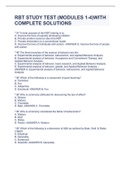
-
RBT STUDY TEST (MODULES 1-4)WITH COMPLETE SOLUTIONS
- Exam (elaborations) • 12 pages • 2023
-
- $11.49
- + learn more
*1A* A main purpose of this RBT training is to: A. Improve the lives of typically developing children. B. Provide another resource about the RBT. C. Provide information on a conventional model. D. Improve the lives of individuals with autism. -ANSWER D. Improve the lives of people with autism. *1B* The three branches of the science of behavior are the: A. Experimental analysis of behavior, behaviorism, and Applied Behavior Analysis. B. Experimental analysis of behavior, Acceptance and C...

-
BCAT Exam, questions and answers with complete top solution
- Exam (elaborations) • 10 pages • 2023
-
Available in package deal
-
- $19.39
- + learn more
BCAT Exam, questions and answers with complete top solution Motivating Operations (MO) An environmental variable that alters the reinforcing effectiveness of some stimulus, object, or event. Contingency Refers to dependent and/or temporal relations between operant behavior an it's controlling variables. Satiation Repeated presentation of a reinforcer weakens its effectiveness and for this reason the rate of responses declines. Positive Reinforcement A type of reinforce...
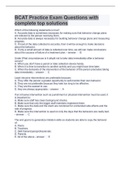
-
BCAT Practice Exam Questions with complete top solutions
- Exam (elaborations) • 13 pages • 2023
-
Available in package deal
-
- $17.49
- + learn more
BCAT Practice Exam Questions with complete top solutions Which of the following statements is true? A. Accurate data is sometimes necessary for making sure that behavior change plans are relevant to the person receiving them. B. Accurate data is always necessary for building behavior change plans and measuring progress. C. If most of the data collected is accurate, then it will be enough to make decisions about the behavior. D. If only a small amount of data is collected over time, we still...
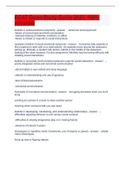
-
BCAT Exam Study Guide 2023, 100% accurate
- Exam (elaborations) • 17 pages • 2023
-
Available in package deal
-
- $18.49
- + learn more
BCAT Exam Study Guide 2023, 100% accurate Deficits in social-emotional reciprocity -abnormal social approach -failure of normal back-and-forth conversation -reduced sharing of interests, emotions, or affect -failure to initiate or respond to social interactions example of deficit of social-emotional reciprocity he teacher tells students to find a partner to work with on a math activity. As students move around the classroom pairing up, Michelle, a student with autism, stands in the ...
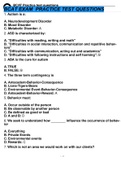
-
BCAT exam latest 2022 distinction level questions and answers, Fall 2022 ( A+ GRADED 100% VERIFIED)
- Exam (elaborations) • 25 pages • 2022
-
- $14.49
- + learn more
1. Autism is a: A. Neurodevelopment Disorder B. Mood Disorder C. Metabolic Disorder: A 2. ASD is characterized by: A. "Difficulties with reading, writing and math" B. "Difficulties in social interaction, communication and repetitive behaviors" C. "Difficulties with communication, acting out and academics" D. "Difficulties with following instructions and self harming": B 3. ABA is the cure for autism A. TRUE B. FALSE: B 4. The three term contingency is A. Antecedent-Behavior-...

-
CARD BCAT EXAM, questions and answers,100% accurate
- Exam (elaborations) • 9 pages • 2023
-
Available in package deal
-
- $14.99
- + learn more
CARD BCAT EXAM, questions and answers,100% accurate Forward Chaining Begin with the first SD- response component in the chain and then continue forward through the remaining SD-response components. Example: Teaching a child to brush their teeth from the beginning of the task with the SD "Brush your teeth" the child gets the tooth brush, turns on the cold water, puts the toothbrush under the water... eventually then gets towel, wipes mouth and hands and hangs towel up. The reinforcer will ...
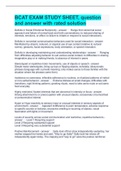
-
BCAT EXAM STUDY SHEET, question and answer with rated solution
- Exam (elaborations) • 10 pages • 2023
-
Available in package deal
-
- $12.99
- + learn more
BCAT EXAM STUDY SHEET, question and answer with rated solution Deficits in Social Emotional Reciprocity Range from abnormal social approach and failure of normal back and forth conversations; to reduced sharing of interests, emotions, or affect: to failure to initiate or respond to social interactions. Deficits in nonverbal communicative behaviors used for social interaction Manifested by absent, reduced, or atypical use of eye contact (relative to cultural norms), gestures, facial exp...
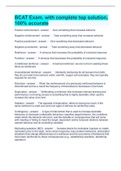
-
BCAT Exam, with complete top solution, 100% accurate
- Exam (elaborations) • 9 pages • 2023
-
Available in package deal
-
- $13.49
- + learn more
BCAT Exam, with complete top solution, 100% accurate Positive reinforcement Give something that increases behavior Negative reinforcement Take something away that increases behavior Positive punishment Give something that decreases behavior Negative punishment Take something away that decreases behavior Reinforcer A stimulus that increases the probability of a desired response Punisher A stimulus that decreases the probability of a desired response ...

-
BCAT EXAM STUDY SHEET UPDATED 2022 A+ Solution Guide
- Exam (elaborations) • 18 pages • 2022
-
- $13.49
- + learn more
BCAT EXAM STUDY SHEET UPDATED 2022 A+ Solution Guide 1. Deficits in Social Emotional Reciprocity: Range from abnormal social ap- proach and failure of normal back and forth conversations; to reduced sharing of interests, emotions, or affect: to failure to initiate or respond to social interactions. 2. Deficits in nonverbal communicative behaviors used for social interaction- : Manifested by absent, reduced, or atypical use of eye contact (relative to cultural norms), gestures, facial...

How much did you already spend on Stuvia? Imagine there are plenty more of you out there paying for study notes, but this time YOU are the seller. Ka-ching! Discover all about earning on Stuvia


